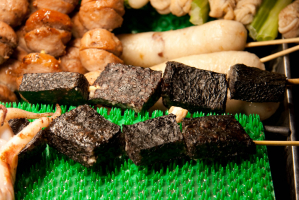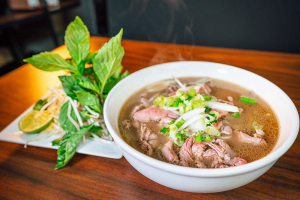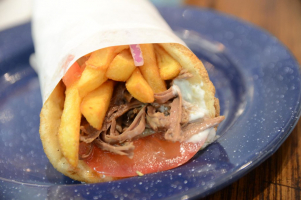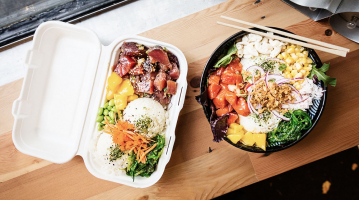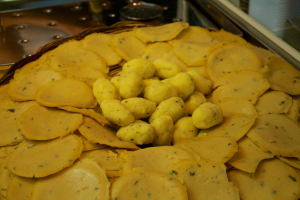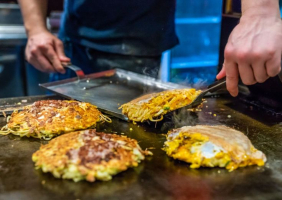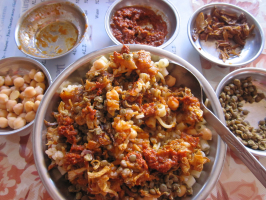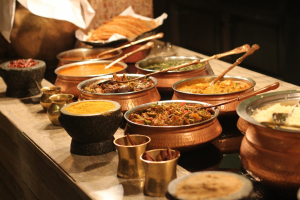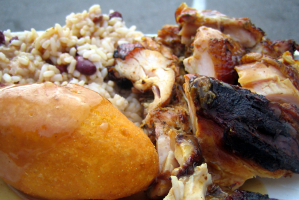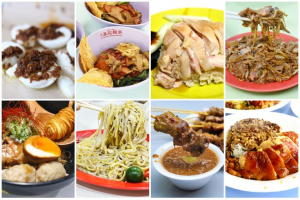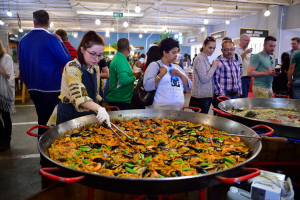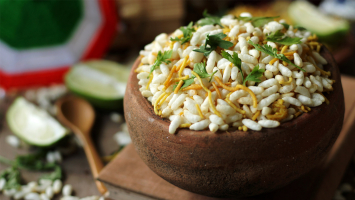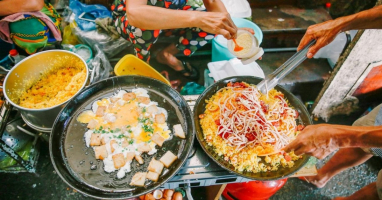Top 14 Most Popular Filipino Street Foods
Filipino street food is a delightful adventure through the diverse flavors of the Philippines. From the unique Balut to sweet Taho and savory Isaw, these ... read more...street snacks are a cultural experience. Whether you're in the heart of Manila or exploring local markets, Filipino street food offers a taste of tradition that leaves you craving more.
-
Standing in first place on the list of the Top 14 Most Popular Filipino Street Foods, Maruya, also known as banana fritters, is a beloved Filipino snack that combines the natural sweetness of ripe saba bananas with a light and crispy coating. This delightful treat is a popular choice for merienda (snack time) in the Philippines and is cherished for its comforting and nostalgic qualities.
To make Maruya, ripe saba bananas are typically sliced lengthwise, dipped in a simple batter made from flour, sugar, and water, and then deep-fried to golden brown perfection. The result is a crispy, caramelized exterior that encases the soft, sweet banana. The batter often has a touch of vanilla extract or sometimes grated coconut for added flavor.
Maruya is commonly served with a dusting of sugar, making it a sweet and satisfying treat. Some variations include a drizzle of syrup or a sprinkling of sesame seeds for extra texture and flavor.
This Filipino delicacy holds a special place in the hearts of many Filipinos. It's not only a delightful snack but also a symbol of home and family, often evoking memories of grandmothers and mothers preparing this delectable treat in their kitchensWhether enjoyed as a simple street food or a homemade comfort snack, Maruya is a delicious representation of Filipino cuisine's sweetness and charm.
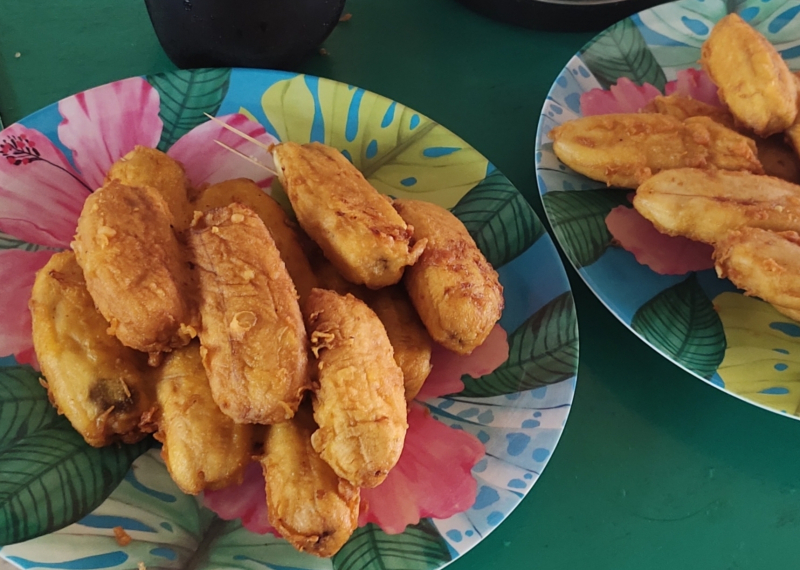
Screenshot of https://commons.wikimedia.org/wiki/File:Baduya_or_maruya.jpg Video by Chef RV Manabat -
Cascaron (plural: cascarones) is a festive and colorful tradition in many Spanish-speaking countries, including the Philippines. These small, hollow eggshells, usually colored and filled with confetti or small treats, are used in celebrations, especially during Easter and other special occasions.
To make cascarones, empty eggshells are carefully cleaned and decorated with vibrant colors and designs. Once they are dried and decorated, they are filled with confetti or small candies. The open end of the eggshell is often sealed with a piece of colored tissue paper to keep the contents inside.
These cascarones are then used in various celebrations, including Easter Sunday, where people playfully crack the eggshells over each other's heads, showering the recipient with confetti or candies. It's a fun and lively way to celebrate and spread joy on these occasions.
Cascarones have become a beloved tradition in many cultures and are often associated with joy, laughter, and togetherness. They add a festive element to celebrations and create memorable moments, making them a cherished part of the cultural festivities they are a part of.
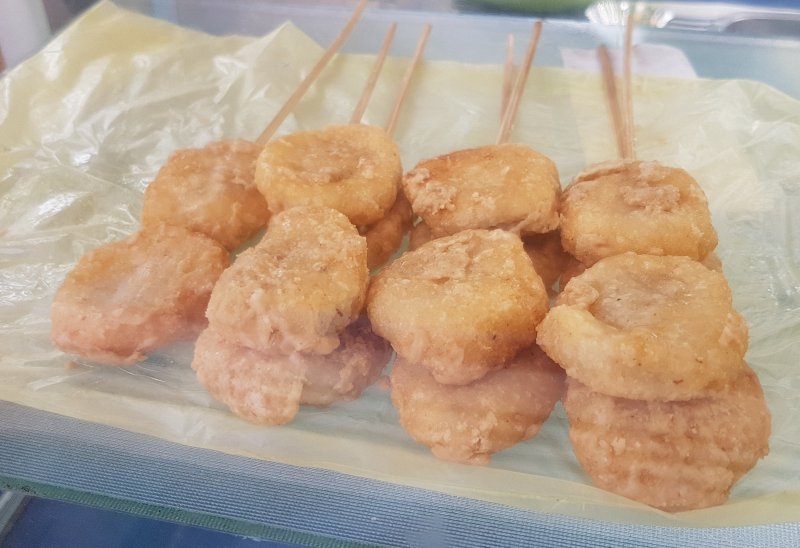
Screenshot of https://commons.wikimedia.org/wiki/File:Cascaron_%28bitsu-bitsu%29_-_glutinous_rice_balls_covered_in_caramelized_sugar_from_the_Philippines.jpg Video by Kitchen Adventures TV -
Pancit Bihon is a beloved and iconic Filipino noodle dish that reflects the rich culinary traditions of the Philippines. This flavorful and versatile dish is enjoyed throughout the country, from daily meals to special occasions and celebrations.
At the heart of Pancit Bihon are thin rice noodles, known as "bihon." These noodles serve as the base for a delectable combination of sautéed vegetables and a protein of your choice, including chicken, pork, shrimp, or tofu. The dish is seasoned with a mixture of soy sauce, fish sauce, and sometimes calamansi (a small citrus fruit) for a distinct Filipino flavor.
To prepare Pancit Bihon, the rice noodles are soaked in water to soften them before being stir-fried in a wok with the sautéed vegetables and protein. The vegetables often include carrots, cabbage, green beans, and sometimes bell peppers. This combination creates a vibrant and flavorful medley of textures and tastes.
Pancit Bihon is traditionally garnished with chopped green onions, crushed chicharrón (pork cracklings), and, at times, slices of hard-boiled eggs. These garnishes add both texture and visual appeal to the dish.
Beyond its delicious taste, Pancit Bihon holds cultural significance in Filipino celebrations and gatherings. It's often present at birthdays, fiestas, and family reunions, symbolizing long life and prosperity due to the length of the noodles. This dish not only tantalizes the palate but also showcases the warmth and hospitality of Filipino cuisine, bringing people together to savor its delightful flavors and celebrate life's special moments.
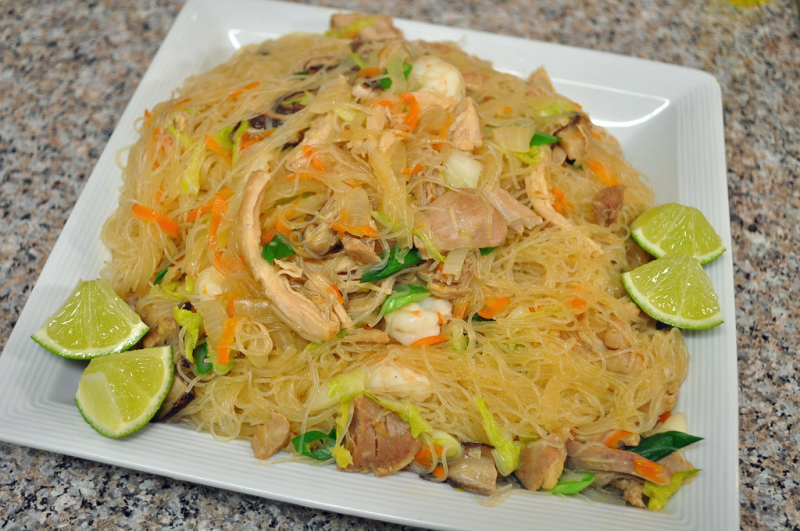
Screenshot of https://www.flickr.com/photos/40726522@N02/4323243199/in/photostream/ Video by Daily Putahe -
Proben, short for "Chicken Proven," is a popular street food in the Philippines, especially in the Pampanga region. It is essentially a Filipino version of chicken kebabs or skewers, often made from small, bite-sized pieces of marinated and grilled chicken.
To prepare Proben, small chicken pieces are typically marinated in a flavorful mixture that includes soy sauce, calamansi or lemon juice, garlic, and various spices. After marinating for some time, the chicken is threaded onto skewers and then grilled or roasted over open flames, resulting in a smoky and savory flavor.
Proben skewers are often served with a dipping sauce, which can vary but is commonly a combination of soy sauce, vinegar, and spices. The combination of tender, marinated chicken with the smoky char from the grill and the tangy sauce makes Proben a delicious and popular street food choice.
Proben can be found in various street food stalls, especially in the Pampanga region, where it is considered a local specialty. It's a savory and satisfying snack that showcases the rich and diverse flavors of Filipino cuisine.
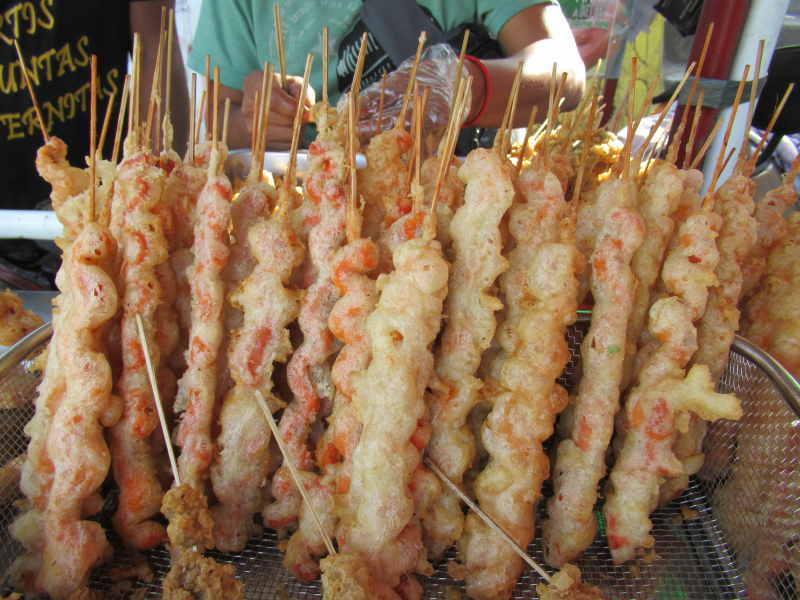
Screenshot of https://commons.wikimedia.org/wiki/File:Street_food_in_Bocaue_14.jpg Video by Hungry Fish Eye -
Lumpiang Shanghai is a popular Filipino dish known for its delicious and crunchy spring rolls filled with a mixture of ground pork, vegetables, and various seasonings. It is a favorite appetizer and snack in Filipino cuisine, often served at family gatherings, parties, and special occasions.
To make Lumpiang Shanghai, a mixture of ground pork is combined with finely chopped vegetables such as carrots, green onions, and sometimes water chestnuts for added crunch. This mixture is seasoned with soy sauce, salt, and pepper, and sometimes garlic and other spices, depending on personal preferences.
The filling is then spooned onto thin spring roll wrappers, and the rolls are tightly folded into small cylinders, similar to the shape of a cigarette (hence the name "Shanghai"). These rolls are deep-fried until they turn golden brown and crispy. Lumpiang Shanghai is often served with a dipping sauce, which can be a sweet and sour sauce, banana ketchup, or a combination of soy sauce and vinegar with chopped onions and garlic.
Lumpiang Shanghai is loved for its savory and satisfying flavor, the contrasting textures of the crispy wrapper and tender filling, and its versatility as a delicious finger food. It's a staple in Filipino gatherings and celebrations, and its appeal extends beyond the Philippines, making it a well-known and beloved dish worldwide.
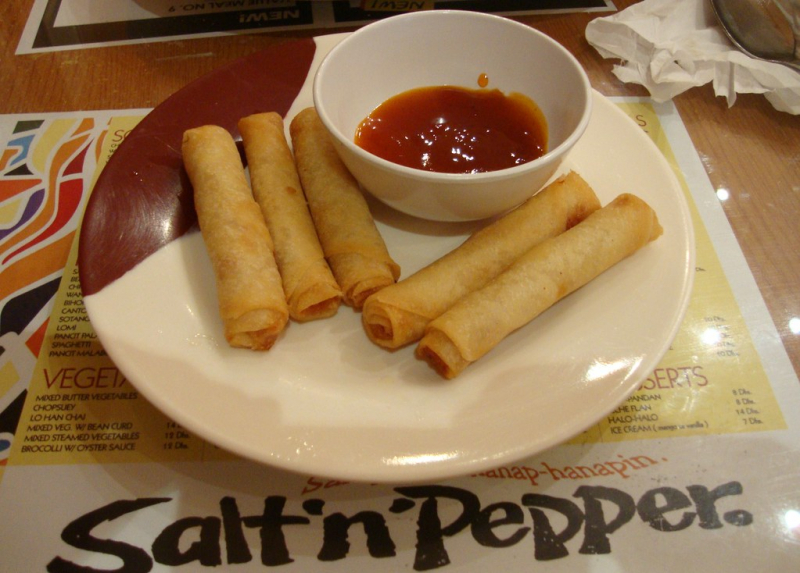
Screenshot of https://www.flickr.com/photos/40726522@N02/4675945278 Video by Kawaling Pinoy -
Ranked 6th on the list of the top 14 Most Popular Filipino Street Foods is Isaw, a popular and beloved Filipino street food known for its distinctive flavors and unique ingredients. This delightful snack consists of skewered and grilled chicken or pork intestines, and it's a favorite among locals and tourists alike.
The preparation of Isaw begins with thoroughly cleaning the chicken or pork intestines. These cleaned intestines are then marinated in a flavorful mixture that often includes soy sauce, vinegar, garlic, and spices. This marinade imparts a rich and savory flavor to the otherwise neutral-tasting intestines.
Once marinated, the intestines are skillfully threaded onto bamboo skewers and grilled over an open flame. The grilling process produces a delightful smoky aroma and a crisp, slightly charred exterior. The contrast between the crispy, caramelized surface and the tender interior makes Isaw so popular.
Isaw is commonly served with a dipping sauce, which can vary, but a classic choice is a mixture of soy sauce, vinegar, and spices. This sauce adds a tangy and savory element that complements the rich, grilled flavors of the dish.
Isaw is more than just a snack; it symbolizes Filipino street food culture. It's a dish that brings people together, and its affordability and delicious taste make it accessible to people from all walks of life. Whether strolling through a bustling market or exploring the vibrant streets of the Philippines, Isaw is a flavorful and aromatic treat that provides a unique and unforgettable taste of Filipino cuisine.
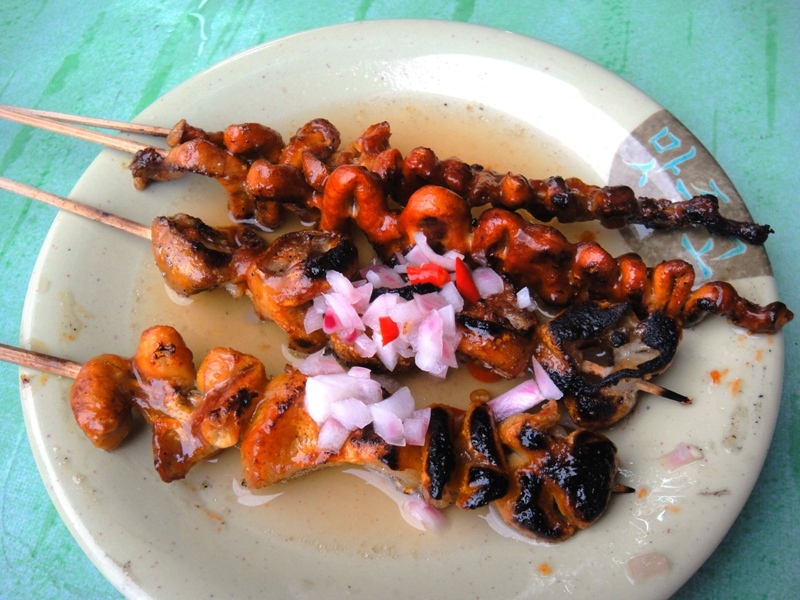
Screenshot of https://www.flickr.com/photos/supermdmd/6870603674 Video by Hungry Fish Eye -
Kwek-kwek is a popular Filipino street food known for its distinctive and vibrant appearance. These bite-sized snacks consist of quail eggs that are coated in a bright orange batter and then deep-fried until they are crispy and golden. The name "kwek-kwek" is an onomatopoeic term, imitating the sound quail makes.
To prepare kwek-kwek, the quail eggs are hard-boiled and then peeled. They are then dipped into a specially prepared batter made with flour, water, annatto powder (which gives the bright orange color), salt, and sometimes other seasonings. After coating the eggs in the batter, they are deep-fried in hot oil until they achieve a crispy and golden exterior.
Kwek-kwek is often served with a vinegar-based dipping sauce that adds a tangy contrast to the crunchy texture and mild flavor of the quail eggs. You can also find a spicier version, often called "tokneneng," which uses larger chicken eggs instead of quail eggs.
Kwek-kwek is a popular street food in the Philippines and is commonly enjoyed as a quick and flavorful snack or appetizer. Its vibrant appearance, delightful crunch, and delicious taste make it a favorite among locals and a unique treat for tourists exploring Filipino street cuisine.
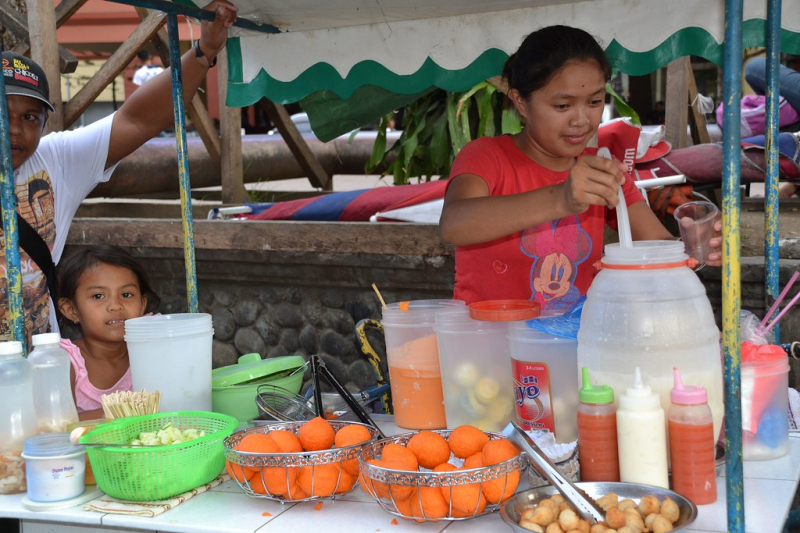
Screenshot of https://www.flickr.com/photos/shankaronline/9103661225 Video by Yummy Kitchen -
Taho, a cherished Filipino street food and a breakfast favorite, offers a delightful and comforting experience. It's a snack that represents the heart of Filipino street food culture, often served by vendors who travel the streets, their arrival signaled by the melodic call of "Taho!"
The second element is arnibal, a sweet syrup created from caramelized sugar. When drizzled over the tofu, it imparts a rich and sugary flavor. The amount of arnibal used can be adjusted to accommodate individual preferences, making each serving of Taho a customizable delight. The final component is sago pearls, akin to small, translucent tapioca pearls. These chewy pearls are generously sprinkled on the sweetened tofu, introducing an enjoyable textural contrast to the dish.
Taho is best enjoyed hot and freshly prepared by street vendors. It is commonly a breakfast treat but is available throughout the day. The combination of warm, sweet arnibal, silky tofu, and chewy sago pearls offers a harmonious blend of flavors and textures.
Beyond being a delicious snack, taho carries a sense of nostalgia and tradition, making it a treasured part of Filipino food culture. It can evoke fond memories and satisfy the cravings and souls of Filipinos of all ages.
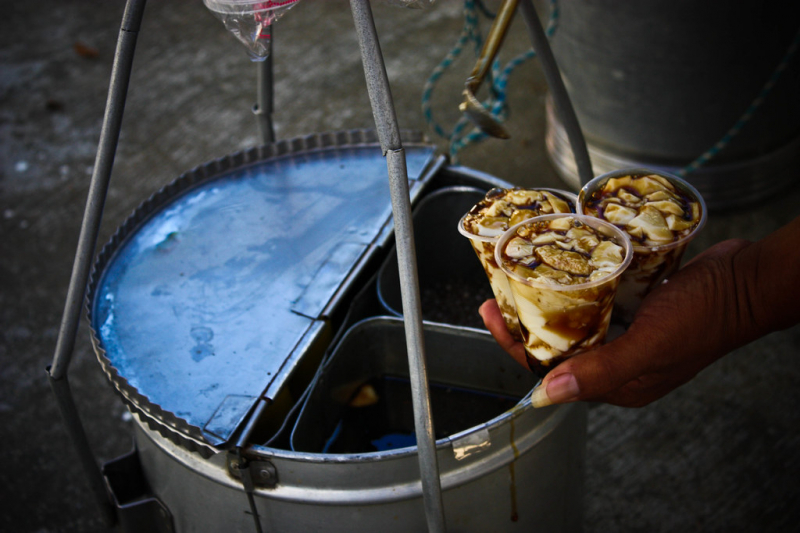
Screenshot of https://www.flickr.com/photos/ludwigsimbajon/3086193207 Video by PagkaingPinoyTV -
Bibingka is a classic Filipino rice cake with a special place in the heart of Filipino culinary culture. This traditional delicacy is often enjoyed during the Christmas season and is a beloved comfort food throughout the year.
Bibingka is typically made from rice flour, coconut milk, and sugar, creating a sweet and slightly dense cake. The batter is poured into a round, shallow pan lined with banana leaves, which imparts a subtle, earthy flavor to the cake. It's then cooked in the oven or over hot coals, traditionally using a special clay oven called a "bibingkaan."
What makes Bibingka truly distinctive are its toppings. It's often garnished with grated coconut, butter, margarine, and salted egg slices. Some variations also include a drizzle of sugar syrup, and it's expected to pair bibingka with a side of grated coconut mixed with sugar for an added layer of sweetness and texture.
Bibingka has a warm and comforting flavor with a unique blend of sweet and savory elements. The coconut milk imparts a rich, creamy taste, while the banana leaves and salted eggs provide contrasting notes. It's a delightful treat that not only celebrates the flavors of the Philippines but also carries a sense of tradition and togetherness, as it's often enjoyed in communal settings during the holiday season and various local festivals.
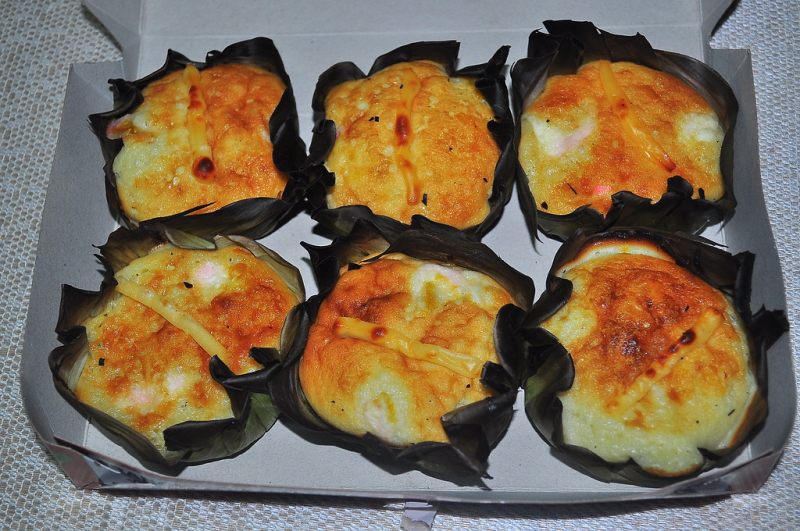
Screenshot of https://www.flickr.com/photos/hulagway/8320285598 Video by Hungry Fish Ey -
Balut is a unique and somewhat controversial Filipino street food that has captured the curiosity and interest of many worldwide. It is essentially a fertilized duck embryo, typically duck eggs, that are boiled and consumed as a popular snack.
Making balut involves incubating the fertilized duck eggs for a specific duration, usually around 17 to 21 days. At this stage, the eggs contain a partially developed duck embryo with features such as feathers, bones, and sometimes the beginnings of a beak. These eggs are then boiled, often in a flavorful broth, until they reach a semi-solid consistency.
Balut is typically enjoyed by cracking open the top of the egg, sipping the savory broth, and then eating the remaining contents, which include the partially developed embryo. It is often seasoned with salt and sometimes vinegar or chili.
Balut is not just a food; it's a cultural and culinary experience in the Philippines. While it may seem unusual to some, it has a strong local following and is considered a delicacy in many regions. Some enjoy it for its rich flavor and unique texture, while others appreciate it as a source of sustenance and nourishment.
Balut has also become a symbol of Filipino street food culture and is often shared and enjoyed among friends and family. It exemplifies how food can carry cultural significance and traditions, even when it challenges culinary norms.
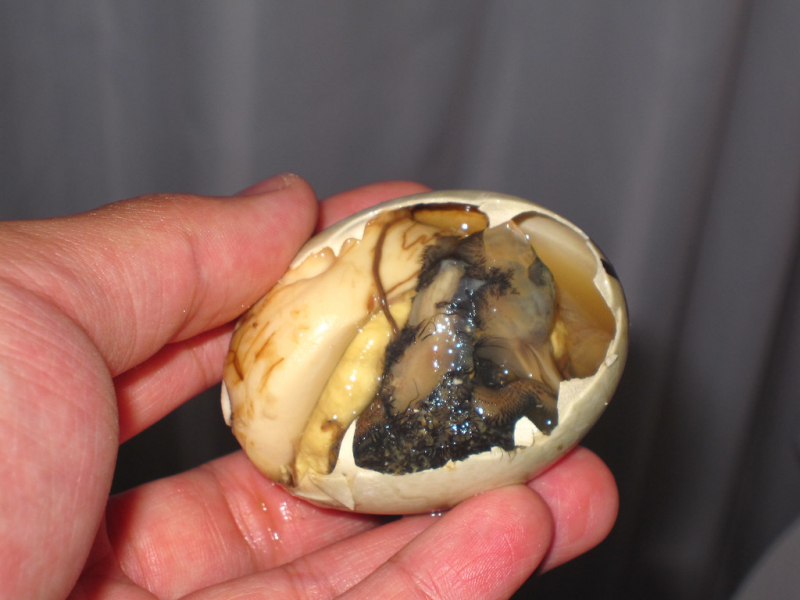
Screenshot of https://www.flickr.com/photos/-kinobe/3184724934 Video by Bisaya Studio -
Siopao, sometimes referred to as Filipino steamed buns, is a popular and savory street food in the Philippines, appreciated for its soft and fluffy dough filled with various delicious fillings. This dish is a testament to the influence of Chinese cuisine on Filipino food culture.
The Siopao's hallmark is its soft and slightly sweet dough, which is leavened and steamed until it becomes fluffy and white. This dough is typically made from ingredients like flour, sugar, and yeast, giving Siopao its distinct texture.
The fillings of Siopao can vary, but the two most common types are Asado and Bola-Bola. Asado features a savory mixture of diced pork, often marinated and simmered in a flavorful sauce. Bola-Bola, on the other hand, consists of a combination of ground pork, sometimes with a hard-boiled egg, Chinese sausage (chorizo), and other seasonings.
The dough is wrapped around the chosen filling, creating a round or slightly flattened bun that's then steamed until the dough is soft, fluffy, and perfectly cooked. Siopao is often served as a convenient and satisfying snack or a quick meal. It's found in many Filipino bakeries and street food stalls.
Combining the sweet dough and savory filling creates a delightful flavor contrast that appeals to a wide range of tastes. Siopao's convenience, affordability, and deliciousness make it a beloved treat and a testament to the fusion of culinary influences in Filipino cuisine.
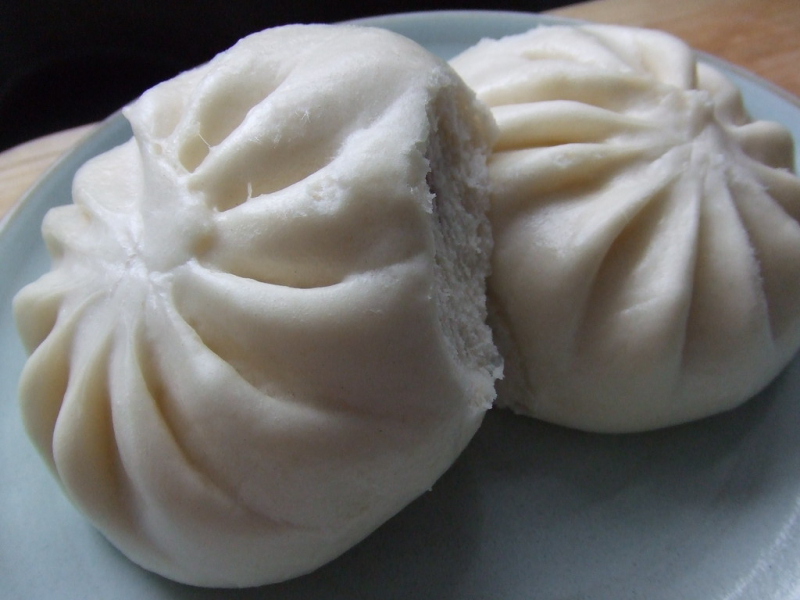
Screenshot of https://www.flickr.com/photos/kodamakitty/3109829580 Video by Ji’s Kitchen -
Siomai is a popular and delectable Filipino street food from Chinese dim sum traditions. These bite-sized dumplings are loved for their flavorful fillings and versatility, making them a beloved snack or appetizer in the Philippines.
The heart of Siomai is its well-seasoned filling. Traditionally, the filling is made from ground pork, shrimp, and various seasonings, including soy sauce, sesame oil, and aromatics like garlic and ginger. This savory blend is finely minced and placed in a thin, translucent wrapper made from wheat starch or rice flour.
Siomai is typically steamed, resulting in a tender, succulent dumpling that retains the rich flavors of the filling. It is often served with a dipping sauce that varies but is typically a combination of soy sauce, calamansi (a citrus fruit), and sometimes chili or garlic for extra flavor.
Siomai vendors can be found on street corners and in food stalls, where they serve these delicious dumplings. Siomai is a versatile dish, often consumed as a quick snack, a side dish, or part of a larger meal.
It's an affordable and satisfying treat enjoyed by people of all ages, and its adaptability has led to various Siomai variations, including those with added vegetables or unique dipping sauces. Siomai is a beloved part of Filipino street food culture, showcasing the fusion of Chinese culinary influences into the heart of Filipino cuisine.
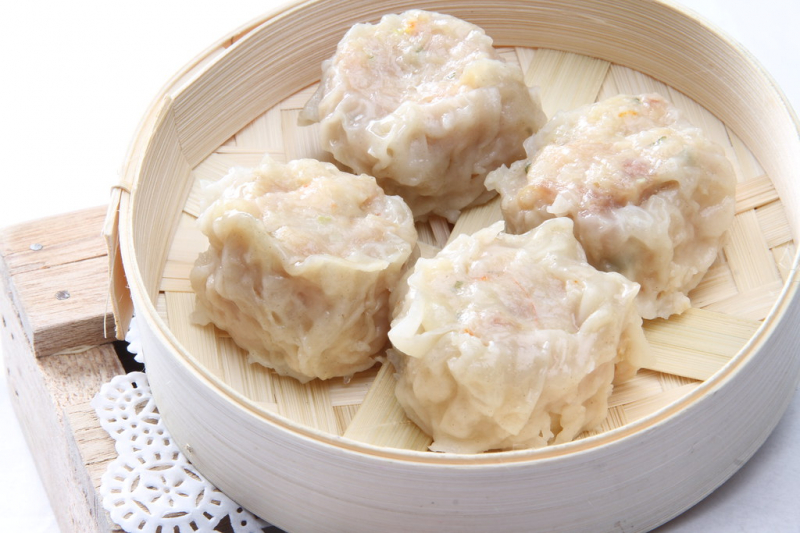
Screenshot of https://www.flickr.com/photos/diaz/15460600384 Video by Panlasang Pinoy -
Sinigang is a beloved and iconic Filipino sour soup known for its refreshing and tangy flavor. This dish represents the vibrant and diverse flavors of Filipino cuisine, and it is a comfort food enjoyed by people of all ages.
The base of Sinigang is a flavorful broth that is made sour by using ingredients like tamarind, calamansi, or green mango. The sourness is balanced with a combination of savory and umami-rich components, such as pork, shrimp, fish, or even beef, creating a harmonious contrast of flavors.
The main protein or seafood is often accompanied by a variety of vegetables, including water spinach (kangkong), radish (labanos), eggplant (talong), string beans (sitaw), and okra. These vegetables are added to the soup to infuse it with their unique textures and flavors, contributing to a well-balanced and nutritious meal. Sinigang is seasoned with fish sauce (patis) or salt and is often garnished with fresh herbs and chili peppers to add an extra layer of flavor and heat, according to personal preference.
This sour and savory soup is not only delicious but also provides comfort and warmth, making it a popular choice for family gatherings, rainy days, or whenever a hearty, flavorful dish is desired. Sinigang's ability to combine different flavors into a single, satisfying bowl is a testament to the complexity and depth of Filipino cuisine. It's a dish that embodies the warmth and hospitality of Filipino culture, and it's cherished for its ability to bring people together over a delicious and comforting meal.
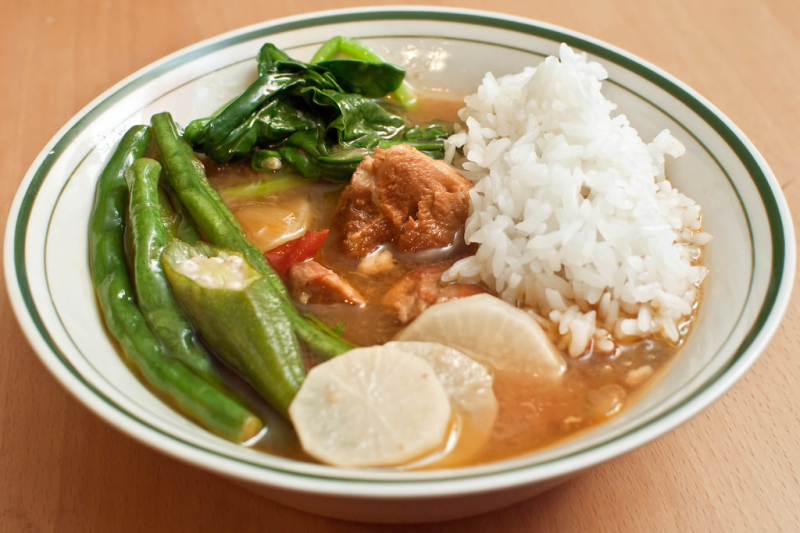
Screenshot of https://www.flickr.com/photos/mattmendoza/4991606157 Video by Panlasang Pinoy -
The final position in the list of the Top 14 Most Popular Filipino Street Foods is Halo-Halo, one of the Philippines' most iconic desserts. It is a sensory and cultural experience rolled into one delightful concoction. Its name, which translates to "mix-mix" in Filipino, is a playful nod to the dessert's core concept: the harmonious blending of a wide array of ingredients, each contributing its own unique texture, flavor, and color to create a visually vibrant and flavor-rich masterpiece.
Common components include leche flan, a silky and indulgent caramel custard, and ube halaya, a strikingly purple yam jam with a distinct sweet and earthy flavor. Sweetened fruits, like jackfruit, banana, and sweet potato, introduce bursts of natural sweetness and tropical charm. Glistening jellies and agar-agar, such as nata de coco (coconut jelly) and gulaman (a type of jelly), contribute delightful chewiness and a hint of nostalgia.
As its name implies, once assembled, halo-halo is meant to be thoroughly mixed. The result is a vibrant, multilayered dessert, both visually and in terms of flavor. Every spoonful presents a delightful surprise as you scoop up a combination of ingredients, each contributing its own unique texture and taste, creating a harmonious blend of flavors and textures.
Halo-halo is not just a dessert; it's a cultural experience. It embodies Filipino culinary creativity and reflects the country's diverse culinary heritage. This dessert holds a special place in the hearts of Filipinos and is often enjoyed at family gatherings, local ice cream parlors, and restaurants, especially during the sweltering summer months. Halo-halo is a delicious way to celebrate the fusion of flavors that defines Filipino cuisine, making it a cherished and delightful part of the nation's food culture.
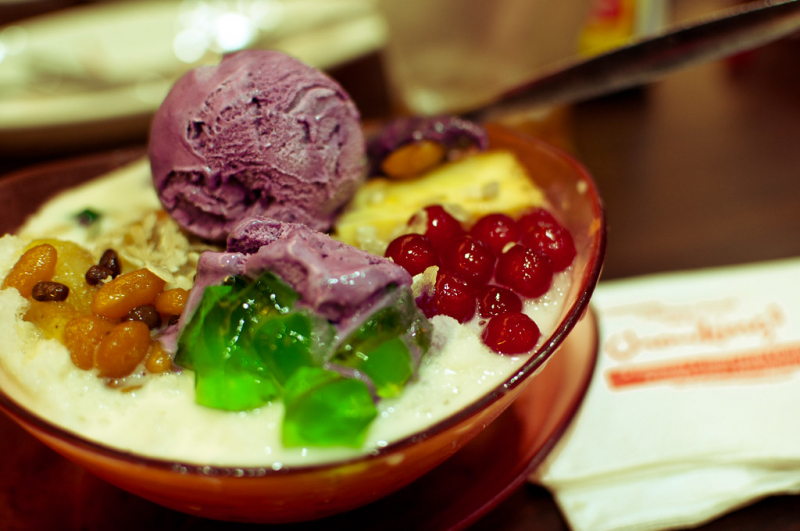
Screenshot of https://www.flickr.com/photos/gunce2010/5517659572 Video by Drew Binsky
















